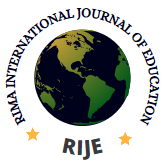Accessibility and Utilization of E-learning Technologies by Business Education Students: Post COVID-19 Pandemic
Comfort Onaigho Nwadiani
Department of Vocational and Technical Education, Faculty of education, University of Benin, Benin City E-mail: nwadianicomfort@yahoo.com
Abstract
This study investigated accessibility and utilization of e-learning technologies by Business Education Students in post COVID 19 pandemic era. Five research questions were raised for the study. One hypothesis was formulated and tested at 0.05 level of significance. The study employed a descriptive survey research design. The population of the study was made up of 382 Business Education students across different levels. A sample size of 115 business education students was used for the study. The instrument for data collection was a structured questionnaire titled Accessibility and Utilization of E-learning Technology for Business Education Students during Post COVID-19 Era (AUETBESPCE). It was validated by experts and a reliability coefficient of 0.78 was obtained. The data collected were analysed using mean, standard deviation (SD), and two sample independent t-test. The findings revealed among others that business education students’ accessibility to e-learning technologies was high while the utilization of e-learning was low. It was recommended among others that the stakeholders of tertiary institutions should provide e- learning facilities to make the students utilize e-learning.
Keywords
Management, Strategies, Innovations, School-Community Relations
Keywords
Abraham, N. M. (2003). Educational administration in Nigeria. Port Harcourt: Pam Unique Publishers
Ejieh, N. (2007). Educational quality and community involvement in Nigeria: Some implications for education planning. Journal of Social Sciences, 10 (2): 43-48
Gestwicki, C. (2015). Home, school and community relations (9th ed.) Belmont, C.A: Cengage Learning.
Glossary of Education (2019). School community. Retrieved from https://edglossary.org/school-community. Date: 15th November, 2021.
Joyce, L. E. (1992). School and Family Partnership. US Department of Education. Education Resource Information Centre [ERIC ED 3437515] from: https://files.eric.ed.gov/full text/ED343715 Date: 10th January, 2022
Mogbodile, T. O. (2003). Fundamentals in educational administration and planning. Nsukka: Magnet Publishing
Okeke, N. O. (2001) Administering education in Nigeria: Problems and Prospects Ibadan: Heimann Education Books.
Lumsden, G & Lumsden, D. (2000) Communicating in groups and teams: Shearing leadership. Belmont-Cardiff: Wadsworth.
Pearle, N. V. & Blanchard, K. (2000). The power of ethical management: London: Random House.
Rangel, C. B. (2000). At- Risk youths school-community collaborations focus on improving students’ outcomes. Washington DC: United States General Accounting Office.
Sanders, M. & Harvey, A. (2002). Beyond the school walls: A case study of principal leadership for school-community collaboration. The Teachers College Record, 104 (7): 1345-1368
Sanders, M. G. (2008). Using diverse data to develop and sustain school, family and community partnerships. Educational Management Administration Leadership, 36 (4): 530-545
Sujatha, K. (2011) Managing external relations: Improving school management. Retrieved from: https://unesdoc.unesco.org/images/0022/002205/22053E.pdf Date: 21st March, 2021.
Tata, U. S. & Abdullahi, M. S. (2014). The relevance of school community relationship on the development of primary education in Azare metropolis Bauchi state, Nigeria. Journal of Research and Method in Education. 4 (6): 23-29
Ukpong, N. N. & Uzoigwe, M.C. (2020). Innovations in managing school community relations and principals’ administrative effectiveness: Implications for attainment of Sustainable Development Goals in Nigeria. Africa Journal of Innovations and Reforms in Educational Management. 1 (1): 503-512.
